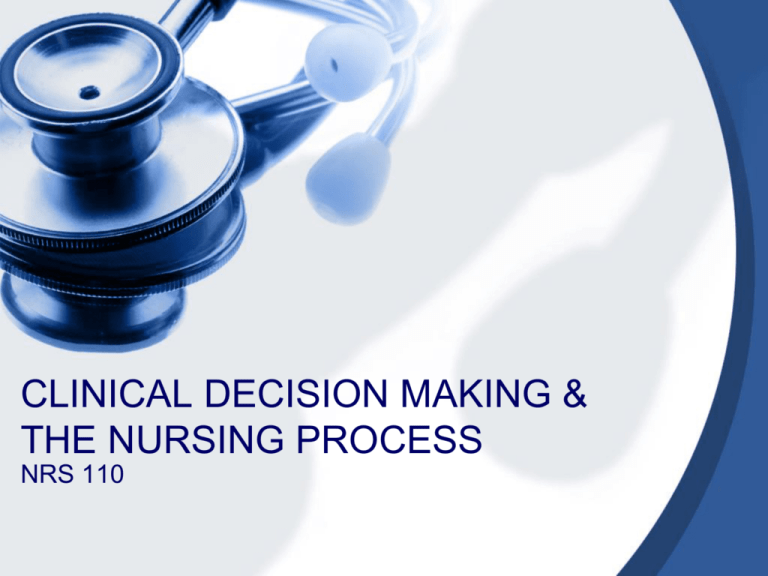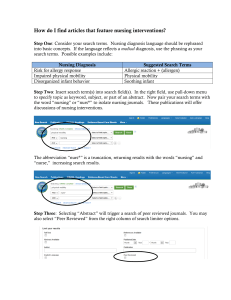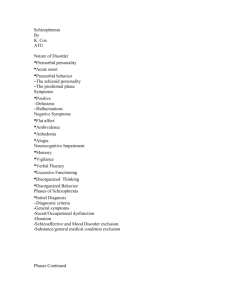CARE PLAN/CONCEPT MAP WORKSHOP
advertisement

CLINICAL DECISION MAKING & THE NURSING PROCESS NRS 110 Critical Thinking Revisited • Knowledge • Experience • Reflection • Intuition Components of Critical Thinking in Nursing • • • • • • • • • • Specific Knowledge Base Experience Critical Thinking Competencies Diagnostic Reasoning Clinical Decision Making Nursing Process Critical Thinking Attitudes Critical Thinking Standards Intellectual Standards Professional Standards Clinical Decision Making • Critical thinking process for choosing the best actions to meet a desired goal • To act or not to act, that is the question! • Criteria used to make decisions • Collaboration • Problem Identification • Who is responsible for making the decision? Level of Critical Thinking • Basic • Complex • Commitment NURSING PROCESS • Assessment • Diagnosis • Planning • Implementation • Evaluation The nursing process in action Step One: Assessment • Collect data (Types of data, Sources of data, Methods of data collection) • Organize data • Validate the data • Record & report Step 2: Diagnosis • Analysis of assessment data leads to problem identification • NANDA list • Types of nursing dx. Anatomy of a Nursing Diagnosis • Problem (Diagnostic label) • Etiology (Related factors and Risk factors) • Defining Characteristics • Differentiating Nursing Diagnoses from Medical Diagnoses • Differentiating Nursing Diagnoses from Collaborative Problems The Diagnostic Process • Analyzing data: Compare data against standards, cluster data, identify gaps and inconsistencies in data • Identify health problems, determine problems and risks, determine strengths Formulating Diagnostic Statements Step 3: Planning • Set priorities • Apply standards • Identify goals & outcomes • Select interventions • Record the plan (nursing care plan) What are the priorities? Maslow’s Hierarchy of Basic Human Needs Guidelines for Writing Goal Statements • Write goals in terms of client responses • Be sure the desired outcomes are realistic and compatible with ordered therapies • Make sure that each goal is derived from only one nursing diagnosis • Use observable, measurable terms for outcomes • Involve the client in the process CONCEPT MAP Ineffective Airway Clearance (Gas Exchange) Step 4: Implementation • Put your plan into action • Perform the interventions • Note patient response to interventions • Record & report Types of Interventions • Independent (nurse initiated) • Dependent (physician initiated) • Collaborative Step 5: Evaluation • Did the plan work? • Was goal achieved? • What was the outcome of the care provided. • Stated in measurable terms. • It’s all about outcomes! Case Scenario • A.A. is an 28 y.o. female who was admitted with pneumonia. She presents with complaint of cold x 2 weeks, dyspnea on exertion, , orthopnea, decreased oral intake. Assessment of patient reveals: • T 103F, P 92, R 22 shallow, BP 122/80 • Dry mucous membranes, hot pale skin • Decreased breath sounds, inspiratory crackles • Ineffective cough-coughing up thick pink sputum • Lethargic, c/o being weak Now lets write the plan down! Concept Map Steps • Place your main issue/problem in the middle • Determine key problems/concepts that have a direct relationship to the main problem • Add clinical data to appropriate problem boxes • Draw lines between related problems. Label with a nursing diagnosis • Identify goals/outcomes • Add interventions • Evaluate patient response to interventions CONCEPT MAP Ineffective Airway Clearance (Gas Exchange)



